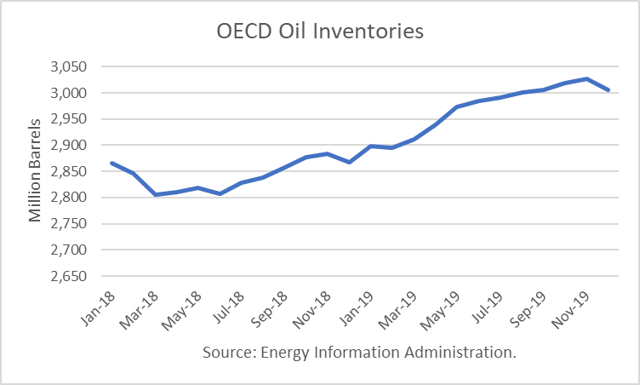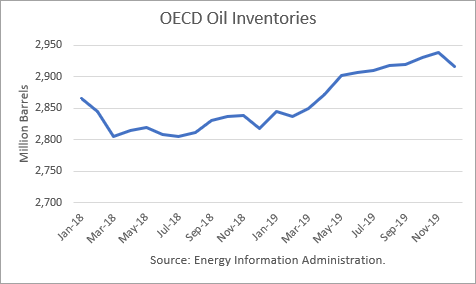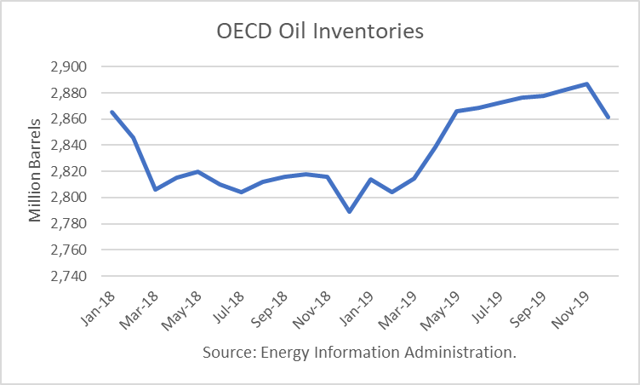Energy demand continues to rise worldwide, driven by the growing population, rapid urbanization, and economic development. Increased energy consumption across residential, commercial, and industrial activities necessitates the expansion and modernization of energy infrastructure to ensure a consistent supply of energy.
The energy infrastructure sector operates assets that offer services crucial for expanding the global economy and ensuring energy security. The industry is supported by stable cash flows, high barriers to entry, long-lived real assets, and inelastic demand, which collectively contributed to double-digit returns in 2023.
Energy infrastructure companies are well-poised to provide essential services for decades to come. In 2024, the sector’s total return is projected to be between 10% and 14%, driven by a dividend yield between 6%-7%, expected dividend growth of 3%-5%, and stock buybacks of 1%-2%.
Notably, as represented by the Alerian Midstream Energy Index, the energy infrastructure sector delivered an impressive 25% annualized return compared to the S&P 500’s 10% from December 31, 2020, to December 31, 2023.
Moreover, the growth in the U.S. natural gas and oil production volumes is expected to set new records, reinforcing the U.S. position as the world’s largest energy exporter.
According to the Energy Information Administration’s (EIA) Short-Term Energy Outlook (STEO), the U.S. natural gas trade will continue to expand with the startup of new LNG export projects. Also, EIA expects increased natural gas exports by pipeline, primarily to Mexico.
In its STEO forecast, net exports of U.S. natural gas will rise 6% year-over-year to 13.6 billion cubic feet per day (Bcf/d) in 2024. In 2025, net exports are expected to grow another 20% to 16.4 Bcf/d. U.S. LNG exports are projected to grow by 2% in 2024 to an average of 12.2 Bcf/d and an additional 18% (2.1 Bcf/d).
As per a Research and Markets report, the oil and gas midstream market is expected to reach $43.41 billion by 2030, growing at a CAGR of 5.9% during the forecast period (2024-2030).
As the energy infrastructure sector has been a hotspot for dividend-seeking investors, ONEOK, Inc. (OKE) and The Williams Companies, Inc. (WMB) stand out as prominent players offering attractive yields and stable returns.
On April 18, OKE’s Board of Directors declared a quarterly dividend of 99 cents ($0.99) per share, paid on May 15 to shareholders of record at the close of business on May 1. Its annual dividend of $3.96 translates to a yield of 4.79% at the prevailing share price. Its four-year average dividend yield is 7.08%.
Further, the company’s dividend payments have increased at a CAGR of 2.7% over the past five years.
Meanwhile, on January 30, WMB’s Board of Directors approved a dividend of $0.475 per share, paid on March 25, to shareholders of record at the close of business on March 8. This represents a 6.1% increase from the company’s fourth-quarter 2023 dividend, paid in December 2023. Its annual dividend of $1.90 translates to a yield of 4.6% at the current share price.
Moreover, the company’s dividend payouts have grown at a CAGR of 5.4% over the past five years. Its four-year average dividend yield is 5.95%. Additionally, WMB has raised its dividend for six consecutive years.
Let’s examine OKE and WMB’s recent financial performance, strategic initiatives, valuation, and growth outlook more thoroughly to determine whether these stocks are worth buying or holding.
ONEOK, Inc. (OKE)
With a $48.23 billion market cap, ONEOK, Inc. (OKE) engages in the gathering, processing, fractionation, storage, transportation, and marketing of natural gas and natural gas liquids (NGL). It operates through four segments: Natural Gas Gathering and Processing; Natural Gas Liquids; Natural Gas Pipelines; and Refined Products and Crude.
On May 13, OKE announced an agreement to acquire a system of natural gas liquids (NGL) pipelines from Easton Energy, a Houston-based midstream company, for around $280 million. The transaction encompasses nearly 450 miles of NGL pipelines in the strategic Gulf Coast market centers for NGLs, refined products, and crude oil.
These pipelines transport various liquid products through a portion of OKE’s capacity to current customers. The company intends to connect the pipelines to its NGL infrastructure in Mont Belvieu, Texas, and its refined products and crude oil infrastructure in Houston, thereby accelerating commercial synergies.
“We expect that this acquisition will accelerate the ability to capture commercial synergies related to our recent Magellan acquisition and future earnings growth,” said Pierce H. Norton II, OKE’s President and CEO.
Also, in March, ONEOK increased its stake in the Saddlehorn Pipeline Company by acquiring an additional 10% interest, bringing its total ownership to 40% as of March 31, 2024.
OKE’s trailing-12-month EBIT margin and net income margin of 21.17% and 12.54% are 11% and 9.7% higher than the industry averages of 19.07% and 11.43%, respectively. However, the stock’s trailing-12-month gross profit margin of 36% is 19.4% lower than the 44.68% industry average.
In terms of forward non-GAAP P/E, OKE is trading at 16.62x, 45.8% higher than the industry average of 11.40x. Its forward EV/EBITDA of 11.34x is 95.6% higher than the industry average of 5.80x. Also, its forward Price/Sales of 1.07x is 38.7% higher than the industry average of 1.49x.
For the first quarter that ended March 31, 2024, OKE reported a 12% year-over-year rise in Rocky Mountain region NGL raw feed throughput volumes. It posted a 4% increase in natural gas volumes processed and a 9% growth in Rocky Mountain region natural gas volumes processed.
ONEOK’s adjusted EBITDA from the natural gas gathering and processing segment and the natural gas pipelines segments were $306 million and $165 million, up 7.4% and 4.4% year-over-year, respectively.
However, the company’s total revenues declined 5.8% from the prior year’s quarter to $4.78 billion. Its operating income was $1.06 billion, a decline of 29.9% year-over-year. Also, net income available to common shareholders and EPS came in at $639 million and $1.09, down 39.1% and 53.4% from the previous year’s period, respectively.
“The strength of our business, underscored by accelerating volumes and a positive synergy outlook, resulted in an increase to our 2024 financial guidance and provides significant momentum into 2025,” said Pierce H. Norton II.
ONEOK increased 2024 net income guidance by $70 million to a midpoint of $2.88 billion. The company raised its EPS to a midpoint of $4.92. Also, its adjusted EBITDA guidance increased by $75 million to a midpoint of $6.175 billion.
Furthermore, its 2024 capital expenditure guidance remains unchanged at $1.75 billion to $1.95 billion. The company also expects that additional annual synergies will meet or surpass $125 million in 2025.
Looking ahead, analysts expect OKE’s revenue for the fiscal year (ending December 2024) to increase by 32% year-over-year to $23.34 billion. However, the consensus EPS estimate of $4.97 for the current year indicates a decline of 9.3% year-over-year. Moreover, ONEOK has missed consensus revenue estimates in all four trailing quarters and consensus EPS estimates in three of the trailing four quarters.
For the fiscal year 2025, the company’s revenue and EPS are estimated to grow 6.4% and 10.4% year-over-year to $24.83 billion and $5.49, respectively.
Shares of OKE have surged nearly 23% over the past six months and more than 44% over the past year.
The Williams Companies, Inc. (WMB)
With a market cap of $50.30 billion, The Williams Companies, Inc. (WMB) operates as an energy infrastructure company. Its four business divisions include Transmission & Gulf of Mexico; Northeast G&P; West; and Gas & NGL Marketing Services.
During the quarter of 2024, WMB placed Transco’s Carolina market link into service. This development contributed to additional fee-based revenues.
The midstream company finished 2023 with a deal to acquire a portfolio of natural gas storage assets from an affiliate of Hartree Partners LP for $1.95 billion.
The transaction includes six underground natural gas storage facilities in Louisiana and Mississippi with a total capacity of 115 Bcf, 230 miles of gas transmission pipeline and 30 pipeline interconnects to LNG markets, and connections to Transco, the nation’s largest natural gas transmission pipeline.
These Gulf Coast natural gas storage assets are strategically located to take advantage of solid LNG and power demand fundamentals, boosting the company’s earnings growth.
WMB’s trailing-12-month gross profit margin of 60.70% is 35.9% higher than the 44.68% industry average. Its trailing-12-month EBITDA margin of 28.40% is 148.4% higher than the 11.43% industry average. However, the stock’s trailing-12-month ROTC and ROTA of 6% and 5.47% are lower than the industry averages of 7.75% and 5.74%, respectively.
In terms of forward non-GAAP P/E, WMB is trading at 22.65x, 98.6% higher than the industry average of 11.40x. Also, its forward EV/EBITDA and Price/Sales of 11.27x and 4.86x are unfavorably compared to respective industry averages of 5.80x and 1.49x.
In the first quarter that ended March 31, 2024, WMB’s service revenues increased 12.5% year-over-year to $1.91 billion, but its total revenues came in at $2.77 billion, down 10.1% from the year-ago value. Its adjusted EBITDA grew 7.7% year-over-year to $1.93 billion.
The adjusted EBITDA growth was driven by the continued outperformance of its transmission, storage, and gathering businesses, which delivered 13% higher adjusted EBITDA compared to the same period in 2023. Also, contracted transmission capacity achieved another record of 33.9 Bcf/d in the first quarter, up 4.3% year-over-year.
In addition, the company’s adjusted net income and earnings per share were $719 million and $0.59, up 5.1% and 5.4% from the prior year’s period, respectively. Its available funds from operations increased 4.3% year-over-year to $1.51 billion.
“Crisp execution by our teams in both integrating newly acquired assets and building large-scale organic projects has us on track to be in the top half of our original 2024 guidance range,” commented Alan Armstrong, president and CEO of WMB.
He added, “Our track record of generating predictable, growing earnings in all market cycles underscores the value of Williams as a resilient, long-term investment with a strong dividend.”
Williams projects adjusted EBITDA at the top half of its 2024 guidance range of $6.8 billion and $7.1 billion. It continues to expect 2024 growth capex of $1.45-$1.75 billion and maintenance capex of $1.1-$1.3 billion, which includes capital of $350 million for emissions reduction and modernization initiatives.
For 2025, WMB expects adjusted EBITDA between $7.2 billion and $7.6 billion, with growth capex between $1.65 billion and $1.95 billion and maintenance capex between $750 million and $850 million, which includes capital of $100 million based on a midpoint for emissions reduction and modernization initiatives. Also, it continues to anticipate a leverage ratio midpoint for 2024 of 3.85x.
Street expects WMB’s revenue and EPS for the fiscal year (ending December 2024) to decrease 5.2% and 4.58% year-over-year to $10.34 billion and $1.82, respectively. For the fiscal year 2025, the company’s revenue and EPS are expected to increase 11.4% and 12.3% from the prior year to $11.52 billion and $2.05, respectively.
WMB’s stock has gained more than 15% over the past six months and approximately 42% over the past year.
Bottom Line
The energy infrastructure sector is well-poised for robust growth and expansion, driven by rising global energy demand amid a growing population, urbanization, and economic development. The industry’s stable cash flows, high barriers to entry, and inelastic demand contributed to impressive double-digit returns in 2023.
Further, the sector is projected to deliver a total return of 10% to 14% in 2024, supported by attractive dividend yields, dividend growth, and stock buybacks. OKE and WMB are critical players within the sector, each with strategic initiatives and strong dividend profiles.
ONEOK’s raised financial 2024 guidance reflects favorable industry fundamentals across its system and continued confidence in synergy expectations. However, the company’s recent first-quarter 2024 results indicate mixed performance, with revenue year-over-year declines and pressure on profit margins.
Despite these challenges, OKE’s dividend yield remains attractive, and its long-term growth outlook is supported by surging energy demand and infrastructure expansion.
Similarly, Williams has demonstrated solid financial health with strategic investments and integration of newly acquired natural gas storage assets. While the company reported year-over-year growth in service revenues and adjusted EBITDA in the first quarter, overall revenues have declined.
WMB’s strong dividend track record and future growth projections underscore its potential as a resilient, long-term investment. The company leverages its existing infrastructure and project development capabilities to serve growing domestic and global security needs while creating sustainable value for its shareholders.
Given the mixed fundamentals, it seems prudent for investors to hold OKE and WMB stocks and wait for better entry points. Both companies offer attractive dividends and long-term growth prospects, but market conditions and stock valuations should be carefully considered to maximize investment returns.



